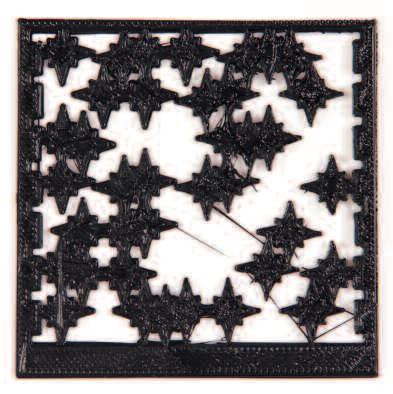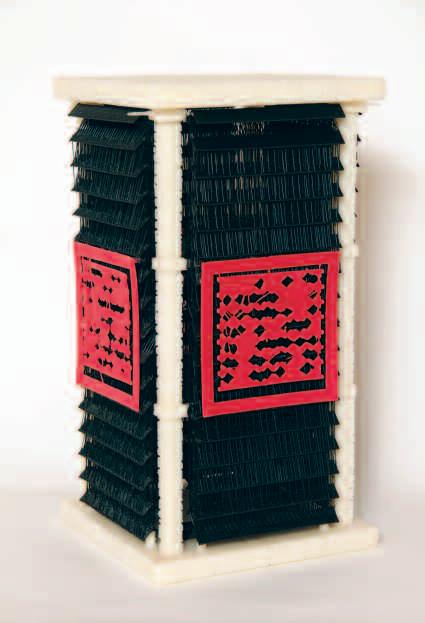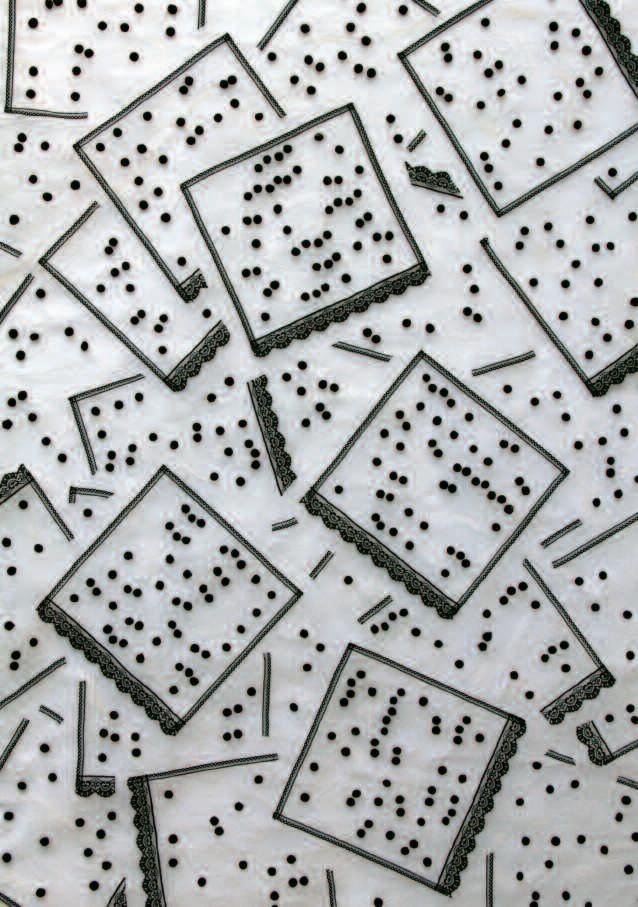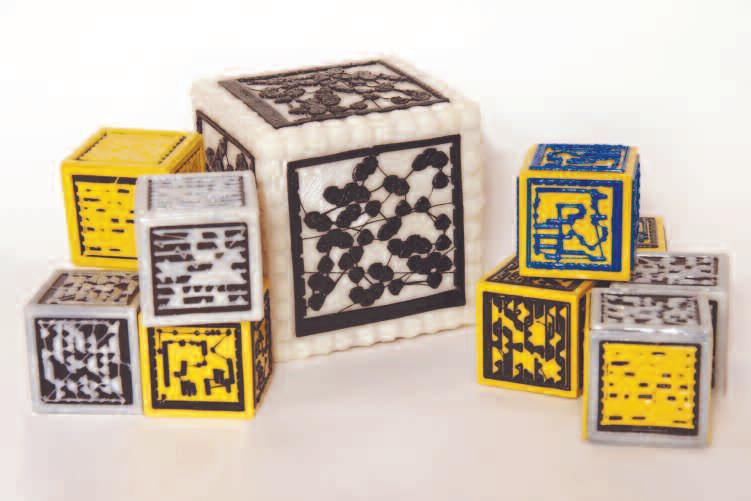

PEDRO MORALES de redes y CADENAS

Reality beyond the apparent
So many utopias tumbled. This opened your eyes. Be grateful.
Rafael Cadenas


“I enjoy exploring the world of the unknown and finding good and beautiful things. I have believed in the fusion between human beings and mobile connectivity since the early years, when the extensive use of mobile phones was merely a good idea. So I got into this unknown immensity with no idea of what I would get, but convinced I would find a lot. Now that no one can conceive their lives without a cell phone, I am able to show what I found in that exploration that has taken years: Mobile Tagging Art, a term I invented to reach the beauty that technological extension of our senses can offer; its aesthetic ability to connect us also with the sublime. Perhaps I’m humanizing that portable phone that, for better or for worse complements us, and bringing it to its own space in art, within the spirit, where poetry lives.”


PEDRO MORALES: EXPLORING, LEARNING, FINDING
Notes on art and new technologies
By Gerardo ZavarceFrom the dematerialization of the pictorial image to the (re)materialization of the digital image
The creating journey of a visual artist such as Pedro Morales (Maracaibo, Venezuela; 1958) is clearly marked by the incorporation of new digital technologies as the essential core of his creative explorations. In 1988, he drastically transformed his pictorial orientation, putting aside the traditional means: pigments, canvas, fabric, and embracing computers as an instrument to expand his aesthetic horizons.
That’s how Pedro Morales started his journey into what he called: the dematerialization of the pictorial image. That is, producing an image using only the properties of a computer as the instrument to create it, therefore, reaching sensorial grounds as a result of the prolific symbiosis between creator, software and hardware.


Pedro Morales was quick to sense that the appearance of computers represented significant challenges for artistic creation, which implies: a) dominating the technical features of the new means; b) overcoming the early and superficial astonishment towards the novelty that could have represented an obstacle to understand the potential of using digital technologies in the context of artistic creation; c) creating a unique language from digital resources; d) exploring the interactive and multimedia possibilities new technologies offer; e) defeating the apocalyptic interpretations of using digital means, f) as well as their unquestioned and condescending integration.

Assuming these dilemmas has shaped up a creative work body that, through time, has utilized a variety of options always related to the crossbreeding of art and new technologies, from holograms and stereograms, digital animation integrating sound and image in motion, videogames, virtual reality devices, the incorporation of the web as a platform for content and a broadcasting medium, to Morales’ recent explorations using technologies applied to mobile telephones (QR Codes, HCCB codes) and incorporating 3-D printing techniques where art operates not as a mimetic representation of reality but, on the contrary, as a reproduction in reality of something previously modeled in the computer’s virtual screen.
The philologist that complains about words 3-D Prints, ABS plastic, Microsoft Tag


Paradoxically, something that started in Pedro Morales’ work as an exploration on the dematerialization of the pictorial image, what some researchers call virtual reality and others prefer to call multisensorial digital simulation, currently transforms, thanks to microelectronic technologies, into the (re)materialization of the visual image. However, this return comes from the conversion of pictorial images into digital signs, images that (re)materialize through a language articulated under the structure of binary codes.
Poetics of digital images
Now, in Morales’ digital creations we can perceive the coexistence of a typically technological perspective and the conscious and strictly formal search for an aesthetic dimension. The confluence of the new digital technologies with the essential sensorial dimensions of the creating process is clearly present in his work, as well as the articulation of new language codes and the proposition of new forms of experience.




This confluence allows us to understand that the creation proposals encompassed in this body of artistic work are not bound by the limits of the technologies applied. On the contrary, it represents the subjugation of instrumental boundaries. It involves the possibility to find, within the framework of the creating process, new alternatives: using new materials, developing or modifying applications, experimentation.
Thus, the confluence of these two dimensions, aesthetic and technological, makes way for a new set of rules for the image and, therefore, for the sensitive and cognitive experience it produces. The visual image becomes: polysemous, interactive, multimedia, open, dynamic, self-referential and virtual. It is evident that through the use of new technologies, the possibilities of the visual image get multiplied, suggesting the emergence of a new wave of poetics that needs to look into the new tensions the digital image puts into play.


Exploring, learning, finding
In Pedro Morales’ work, the incorporation of new technologies represents an exploration of grounds of inhospitable, unknown geographies. In the artist’s words, It’s not about adapting to new technologies, on the contrary, it’s about owning them and using them to cater to my aesthetic needs and interests. I assume technology to humanize it; technological instruments reproduce that which represents the purpose of my creative experimentation, what they reproduce is marked by my identity and sensibility as creating subject.
Now, this creative experimentation, this willingness to create allows him to explore beyond the boundaries of what’s known, it represents a journey to the limits of the imagination that leads both the creator and the audience into a permanent learning process. In simple words, Pedro Morales summarizes it as: exploring the unknown, exploring and finding; learning, learning and learning. Exploring, learning and finding. There lies the dignity of his aesthetic search: an experimental effort to find, in the context of the uncertainty involved in innovation, other ways of conceiving and experimenting visual sensibility, a way of humanizing the applications of new technologies.

If the sensitive experience of art is the possibility of the other, of the difference, then the unknown in the field of new technologies foster and enrich the creative work of Pedro Morales and, based on his aesthetic inquiry at the confluence between art and new digital technologies, it enables it to restore the sublime, that is, the beauty in all forms and signs that permanently accompany the creating exercise of Morales throughout the intricate paths of the human horizon.

RAFAEL CADENAS, THE REAL, THE INVISIBLE
Jacqueline GoldbergIf the poem isn’t born, but your life is real, you are its incarnation. You live in its unconquerable shadow. It accompanies you unrealized diamond.
Rafael CadenasA few years ago, when Rafael Cadenas’ poems started circulating the Internet, neither the poet nor us, his readers, could conceive a more technological way of reading him. E-books were still far from the picture. And as it usually happens, the future dismantles any notion of novelty, and illusions end up feeding our most deeply rooted imaginary. It is from a tangle of possible impossibilities that the artist Pedro Morales reveals a different Rafael Cadenas, showing us that the commotion produced by poetry allows new meanings simply by modifying our perception processes and the way we approach the word.

Morales conceals the words of the well-known and awarded Venezuelan poet in a set of small, weaved acrylic or thread squares. At first sight, these squares constitute a work of visual art that, though quite suggesting, doesn’t fall out of the “conventional”: rich abstract weaves for everyone to adapt to their own references. That’s the visible piece, the one that occupies the exhibition room, an object that can be acquired and moved to any space. Morales’ artistic proposal consists of making us pass through that warp using mobile telephones or portable multimedia devices with built-in cameras by pointing at the squares using the software Microsoft Tag, which instantly recognizes them as 2D barcodes. These codes are links to Rafael Cadenas’ poems.
Poetry, just like the art piece, becomes an interactive experience. It travels from a coded yet poetic element into the digital world and then to a reading that, at the same time, unveils poetry’s very own cogs. It’s a kaleidoscopic game of tectonics: those of Pedro Morales’ pieces and those of Rafael Cadenas’ poetry, a set of metaphoric layers that transform the apparent into invisible and the concealed into reality.


CADENAS: Loudspeaker

3-D Prints, ABS plastic, Microsoft Tag
230 x 140 cm
2011

Exhibition visitors ¿spectators, readers, explorers, experimenters? are required to carry out specific actions to reach wherever their own yearnings allow them. They can stop at the delicate beauty of the weaves and not admit they are Microsoft Tags. They can admire the material representation of those codes, so common in the world of advertising, and still feel immersed in their particular aesthetics resembling medieval codices, Mayan symbols and even the Braille writing system, without ruling out a dialogue with kinetic art. And finally, using technology, they can get redirected to Rafael Cadenas’ poems to start a new ride, the journey of linguistic polysemy and the dejection of the soul.
As a matter of fact, as this catalog offers us the opportunity to take home a good part of the Microsoft Tags we’ve seen in the exhibit hall, it makes us reevaluate Walter Benjamin’s precepts on reproducibility and the long voyages of hermeneutics, epistemology, hypertextuality and digital hyper-reproducibility. Behind the lithographic images, the poem remains invisible, but turns into words when using the same tools demanded by the “real” piece in the gallery.

In people’s electronic devices, the poems come out as light, abstract shapes the eye transforms into words and speech: light tamed by reading, an artificiality that achieves the unveiling of the poem.
In more than half the art pieces in the exhibit De redes y CADENAS (Of Networks and CADENAS), Rafael Cadenas’ poetry is reviewed and revisited with an unprecedented perspective that doesn’t modify its certainty as it gets transferred into a digital container. It is not by chance that this catalog begins with a quote by Cadenas about tumbled utopias. Both creators have known how to get rid of paradigms, keep their eyes wide open and, especially, be grateful.
“Real words grow in pages,” writes Rafael Cadenas. But Pedro Morales makes these words abandon any hint of reality at least the most immediate and obvious one— to appear in a fragile screen from where, just like in a book or a website or people’s memories, they continue their journey into eternity.

Writing
Assembly, feathers, inkjet, Microsoft Tag
28 x 22 cm
2009
Readings
Assembly, feathers, inkjet, Microsoft Tag 28 x 22 cm
2009
Words
Assembly, feathers, inkjet, Microsoft Tag 28 x 22 cm
2009



Doing Well by Doing Good.
Multimedia Installation
A LOOK AT THE LAKE is an intervention in Maracaibo’s urban landscape, a collective communicational experience that uses the aesthetic features of fractal shapes, communications technology, and the laws of chaos to create a sustainable, self-organized social channel originated from mass-consumption-product distribution systems (e.g. pop soda), or from the public transportation system of a given area of the city.
Using 2D mobile phone codes as a connection tool, I propose pedestrians to interact with the movable installation using their phones – a device known by everyone, everywhere. Once they realize they can interact with the art piece, if they choose to scan it, they’ll find messages, quotes focused on sustainable, green principles, taken from the best practices of the corporate world, which enhance the value of appreciating a battered natural treasure.
I reinvent two-dimensional codes (Microsoft tags). I build them manually. I push technology to the limits and force it to read them, despite the human error in their manufacture. It is a purpose to humanize technology for the sake of aesthetics.
The installation promotes the creation of collaborative networks: volunteer users with two things in common: a telephone and an urge to communicate with the piece. A portion of the city gets nourished at random, from within, as a result of the increasing exposure to this interaction.
Within the intimacy of a handheld screen, art promotes a sort of social network; people using technology to raise environmental awareness. I mix the concepts of art, an homage to beauty, and science which, in its utility, provides a social meaning.


 The game of life
3-D Prints, ABS plastic, Microsoft Tag
12 x 12 x 12 cm
5 x 5 x 5 cm
2011
The game of life
3-D Prints, ABS plastic, Microsoft Tag
12 x 12 x 12 cm
5 x 5 x 5 cm
2011

Passion for the unknown
“To me, finding an intimate and personal relation with digital media represents a form of passion. Through my work, I make these means adapt to my needs, my identity is always present in my work. Exploring motivates me, I am drawn to the unknown, to exploring the unknown. I prefer to be constantly exploring and finding. It’s not about searching a preset result, on the contrary, the essence of my work is based on exploring and finding (…) Making digital means do what I intend it to do, forcing it to do things it wasn’t originally designed to do. This effort involves acquiring knowledge beyond what’s known, aiming beyond the apparent. This passion for the unknown has made 3D printing a possibility for art and has set a new horizon for the applications of this new technology. So, it’s about humanizing, turning technologies into a sign of human expression. If they are designed to do “a,” we can make them do “b,” “c” and “ z. ” Exploring the unknown means going beyond, breaking barriers.”





The



Learning by doing
“Over the last few years, I’ve done nothing but learn, learn and learn. I have dared though, to look a little beyond what I’ve learned, to break the pre-set barriers of both the artistic and technological worlds, therefore facing a field of infinite learning opportunities. We learn through the constant, dynamic and daily interaction between the materials we use and the conceptual horizons we establish with our work.
It takes courage, strength, confidence and determination to achieve satisfactory results and agree to show them. I resisted at first the idea of having a solo-show. I never think I’m ready, my work is always experimental. It is a game I play with the constant manipulation of the materials to generate my pieces. My current interests revolve around tri-dimensionality, I am constantly enriching my knowledge about this new horizon, I intervene it by changing algorithms, altering routines, by learning on the go.”

Why don’t you shut up?
QR Code, plastic beads, coin, nylon
34 x 30 cm
2008

“Nowadays, art and knowledge are connected. In a world full of symbols and information, it is impossible to escape knowledge. Managing information is key in any field. Technological and scientific advances are present in all spheres of life. So, in order to go further, we need to learn. There’s so much information that sometimes it eludes us. So, we need to enquire on our own, as there will always be countless more possibilities than we can ever find. I emphasize learning. I would not be able to show my work without what I have learned. The only way to find the unknown is by discovering it, and the only way to discover the unknown is by learning. To me, discovering and learning represent the greatest excitement.”


To Rafael Cadenas. For saying so much. Brief and enlightening. Dawning. Bravo, Cadenas!

http://pedromorales.com/cv/
Pedro Morales (Maracaibo, VE. 1958) is a pioneer of digital art in The Americas. ‘La Mirada,’ (The Gaze), ca. 1989, made entirely in a 8088 PC with 256K RAM memory is one of the first works of digital art documented in the region. Ever since, expressing the warmth of the heart and the inner landscape in his artwork became part of the challenge of pushing the aesthetic limits of what was just starting to be known as “virtual reality.”
Morales was honored with Salon Arturo Michelena’s Arts Research Award in 1991. His work has been in individual exhibits at the Sofia Imber Museum of Contemporary Art of Caracas, and his piece “Generacion Fractal” (Fractal Generation) (1994) received the FAMA Award, granted by the fund for arts sponsored by Fundación Polar, and the Grand Prize in the 20th Art Show of Aragua (1995). The Museums of Contemporary Art of Maracay and Maracaibo both exhibited his Naturaleza Virtual (Virtual Nature) (1997). He has participated in Prix Ars Electronica in Linz, Austria (2002, 2005).

Morales represented Venezuela in the 50th Venice Biennale exhibition “The Dictatorship of the Viewer” (2003) with his iconic work “City Rooms,” one of the first artistic creations made on and for the internet. Censured by the government of his country, it was still viewed (navigated) by thousands of people online. City Rooms is a high point in his career and a landmark for Venezuelan contemporary art.
For two decades, Morales’ research in visual arts has maintained an intimate focus, using everyday household events as background for his digital work. He turns to fractal geometry to exhibit his mosaics, the home he means to portray, using the beauty arduously taken by the artist from technology.
Pedro Morales has explored his vision of the picture within the picture using stereography, his virtual volumes, freed from wires and screens and yet loyal to their digital nature. His exhibit Bordados Porno (Porn Embroideries, 2007) was the result of a long creative seclusion that led him to approach tri-dimensionality on the plane. 3D vision, a recent fashion, has been widely researched and documented by Morales since the late nineties.
Bi-dimensional codes (QR and HCCB), now popular in mobile telephones and printed ads, have been dismembered and reassembled with paper and leather flowers and pieces of plastic on raffia by Morales since 2007. In his most recent works, Pedro Morales experiments with new materials and techniques, using elements produced by 3D printers, abstractly-created volumes turned into objects without going through industrial processes, displays with messages that can be deciphered with a mobile phone. His recent 3D pieces come from open-source handmade printers assembled by the artist himself. His work also talks with his own voice. Part of the advanced interactivity of his recent work, mediating mobile connectivity, is the fact that each code can bear a personal message which can be changed as life goes on, uploading phrases, URLs and feelings onto the art piece, just like any other social network.
In 2010 he participated in the Shanghai Art Expo in China, after having received invitations from Madrid, Bogota and Miami. He participated in the exhibit “Vital Lake” at the Lia Bermudez Center for the Arts in Maracaibo. In 2011, his individual exhibit “de redes y CADENAS” (of networks and CADENAS) at Galeria D’Museo is an artistic statement of the particular 21st-century phenomena known as “pan-communication”: Everything and everyone bearing contents and meanings in all combinations possible. Without sacrifice of the aesthetic engagement.



Cuántas utopías derrumbadas
Cúantas utopías derrumbadas
Esto te abrió los ojos. Agradécelo.
Vanidad
El insignificante emperador de Liliput se consideraba a si mismo, sin mostrar ninguna prueba, “terror y delicia del Universo”, aunque había conocido a un destacado agente del entonces mayor Imperio, que decía llamarse Gulliver.
Homo sapiens novus
Según las últimas investigacionesde los paleoantropólogos, el hombre nuevo de la revolución tiene 150,000 años.
En realidad
Los que matan en realidad no han vivido
Contradicción
Cristóbal Colón tantea buscando en la oscuridad su estatua
Los que la derribaron aún hablan español
The philologist that complains about words
El filólogo que se queja de las palabras las espía, les averigua su vida, lugar de nacimiento fecha linaje eclipses regresos, qué desean, cómo vinieron a dar aquí, dónde se esconden para no ver, a qué hora sufren, o si aún cantan. Hace tanto se amigó con ellas. les reprocha, sí, que se vuelvan cor tesanas, que se alquilen, que se deshonren, pero sobre todo que cuando los dictadores las usan, ellas no les queman los labios.
No está de más tener cuidado
Lawrence M. Kraus dice que el Homo sapiens fue la primera criatura en 4,000 millones de años de este planeta que desarrolló una explícita espiritualidad Tan explícita fue que él acabó con sus predecesores que tuvieron la mala suer te de topárselo Homo neanther talensis fue, al parecer, su última víctima. En otras palabras: somos peligrosos.
Dialog according to a dictator
Versión originaria: Cuando yo dialogo no quiero que me interrumpan Versión segunda: Yo dialogo, pero advier to que no cedo en mi posición Versión tercera: En diálogo, los que me contradigan deben reconocer de antemano su error Versión cuar ta: Después de cavilar, dictamino humildemente que el diálogo es innecesario.
Mister y Vivir en el misterio, frase redundante
Brilliant Career
Desconocía su idioma; por eso hizo una brillante carrera política.
Residencia fija
La poesía no tiene residencia fija, por eso es tan difícil dar con ella.
Shelter
Hablo desde la cárcel que tu también conoces, pero ¿qué pasa si la aceptamos?
¿no se vuelve albergue? ¿no se une a nosotros para formar un ser real?
Infantil
La enfermedad infantil del comunismo es el comunismo.
Pluralismo
El pluralismo vive amenazado por los fanáticos de toda calaña.
Una distracción
El Emperador ordena: debemos amarnos como hermanos Para cumplir con tan piadoso propósito he decidido aumentar al máximo el número de soldados de mi ejército
De crónicas chinas.
CADENAS: loudspeaker
¿Qué hace aquí colgado de un látigo la palabra amor?
Peace
No me arrastrarás a tu guerra
CADENAS to fly Coraje, llegaremos a la salida. Caminemos entonces todas las leguas, amor tajados pero caminemos. ¿Alguien responderá al fin? Ceremonia en pos de un orden donde el cuerpo encaje, no este interminable descampado. Algo me dice que en el fondo del fondo estamos unidos. Unidos y separados
Unidos
Writing
Escribir me facilita la respiración
Readings
Lecturas: avíos para pernoctar.
Words
Las palabras reales crecen en la página.
Black little angels
Pintor que pintas tu tierra, si quieres pintar tu cielo, cuando pintas angelitos acuérdate de tu pueblo y al lado del ángel rubio y junto al ángel trigueño, aunque la Virgen sea blanca, píntame angelitos negros.
Andrés Eloy Blanco
PEDRO MORALES de redes
octubre - noviembre 2011
y CADENAS
Edición
D’Museo
Textos
Gerardo Zavarce
Jacqueline Goldberg
Pedro Morales
Nicomedes Febres
Fotografía
Carlos Germán Rojas
Diseño Gráfico
Luisa Ponte C.
Dirección editorial
Marco Antonio Suárez
Impresión
Gráficas Lauki
D’Museo
Centro de Ar te Los Galpones, Galpón G2, Av. Ávila con 8a transversal, Los Chorros.
Caracas, Venezuela
Telf: (58 212) 2840943 / 2840177
dmuseo@gmail com
www.dmuseo.com

